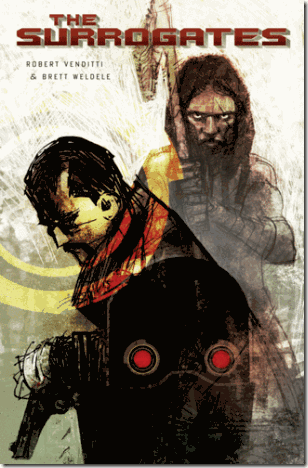The Surrogates is a graphic novel that postulates a world in which we live vicariously through simulacra of ourselves to which we are connected cybernetically. Safe at home, we can work dangerous jobs without fear. A fireman’s surrogate can dash into a flaming building to rescue its inhabitants without any fear of his actual body suffering damage. Someone walking down the sidewalk need not fear falling objects, or an out of control car lurching onto that sidewalk. If an accident occurs, only the surrogate will be damaged. Its human operator will remain, safe and sound, at home.
In this world, surrogates have become big business – an overwhelming majority of United States citizens either own a surrogate outright, or are buying one on credit terms. This is the world that writer Robert Venditti and artist Brett Weldele have created. On the surface, it seems like an ideal world – once dangerous jobs are now no riskier than doing a crossword puzzle; sexually transmitted diseases no longer bar us from experimenting as we please. Even vanity is swerved – one’s surrogate can be specifically ordered to represent an idealized image of oneself.
There is, however, a problem. A figure in black is destroying surrogates. It has happened often enough that the police – and detectives Harvey Greer and Pete Ford – must find out what’s happening, how it’s happening, why it’s happening, and then make sure it stops happening. Easy-peasy.
Only, it’s not.
There are elements that believe the surrogates to be an abomination in the eyes of God [something about man putting himself above God] – but there doesn’t seem to be any connection between that faction and the black clad destroyer of surrogates.
As their investigation proceeds, Greer’s surrogate is damaged and he makes the decision to carry on the investigation in his real body [there’s a nice bit of foreshadowing of this decision near the beginning of the story] – though both his partner and his wife try to talk him out of it.
From additional materials in the book, The Surrogates: Behind the Scenes, I gather that this is Robert Venditti’s first attempt to write any form of comics. As debuts go, it’s kind of like Jason Reitman’s Thank You For Smoking. Not only do all the ducks line up in a row, they are particularly beautiful ducks.
The Surrogates is a meditation on being human. If one’s mind occupies, through whatever means, a surrogate that can be destroyed without damaging its operator, is that combination of Human and machine still Human? Is removing unwanted/unnecessary pain from one’s experience necessarily a good thing? If one experiences sensations of any kind through a remote simulacrum, is that experience, however real it might see, still a valid experience?
The anti-surrogate faction in the story is fanatically opposed such an idea. Its members live life in the human shell in which they were born – and preach that surrogates are evil. Venditti, through Greer’s decision to work in his own body, suggests that these techno-terrorists just might be right.
Brett Weldele’s art sets the tone for the book right from the cover. His art is messy, impressionistic and capable of bridging the simulated life of the surrogates and the organic life of their operators smoothly and bringing unique qualities to each. Like Venditti’s story, Weldele’s layouts are precise and appropriate to the plot. While his art has great impact, it never shows off – much like the surrogate-ized Greer. Even so, it pulls the reader in with its balance of over and understatement. It is compelling without feeling forced.
Originally serialized by publisher Top Shelf, the graphic novel collection includes peripheral printed matter that appeared at the end of each issue to add depth to the world of The Surrogates. These materials range from an article published by The Journal of Applied Cybernetics, to a typed record of a post-disaster interview, to promotional material describing the benefits of owning a surrogate – and how to choose the accessories you need.
There is also a gallery of covers that precedes the Behind the Scenes material, which takes us through the process of The Surrogates’ creation – from script to layouts to finished work [including The Ad Campaign, and even a deleted scene]. Following the Behind the Scenes piece, there is a pin-up gallery that features work by Steve Lieber, Kieron Dwyer and Ben Templesmith, among others.
Final Grade: A+
